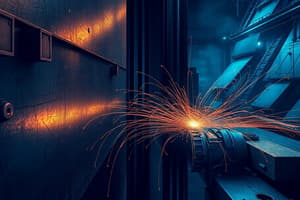Podcast
Questions and Answers
What is machinability?
What is machinability?
The ease with which a metal can be machined to an acceptable surface finish.
Which of the following is not a characteristic of materials with good machinability?
Which of the following is not a characteristic of materials with good machinability?
- Require little power to remove material
- Achieve cutting at high speed
- Easily obtain a good finish
- Cause rapid tool wear (correct)
Machinability is a material characteristic.
Machinability is a material characteristic.
False (B)
Which material is considered a reference material for machinability rating?
Which material is considered a reference material for machinability rating?
Match the machinability criteria with their respective application in cuts:
Match the machinability criteria with their respective application in cuts:
Which of the following materials is likely to have poor machinability due to forming BUE?
Which of the following materials is likely to have poor machinability due to forming BUE?
Flashcards
Machinability
Machinability
The ease with which a metal can be machined to a good surface finish.
Tool Life
Tool Life
The duration a cutting tool can operate before needing replacement.
Chip Formation
Chip Formation
The process of material removal during machining, including friction and BUE.
Surface Finish
Surface Finish
Signup and view all the flashcards
Cutting Forces
Cutting Forces
Signup and view all the flashcards
Power Consumption
Power Consumption
Signup and view all the flashcards
Specific Energy
Specific Energy
Signup and view all the flashcards
Metal Removal Rate (MRR)
Metal Removal Rate (MRR)
Signup and view all the flashcards
Free-cutting Steel
Free-cutting Steel
Signup and view all the flashcards
Machinability Index
Machinability Index
Signup and view all the flashcards
Study Notes
Machinability
- Machinability refers to the ease with which a metal can be machined to an acceptable surface finish.
- Good machinability implies needing less power to remove material, achieving high cutting speeds, and easily obtaining a good finish, along with minimal tool wear.
- Machinability is complex and difficult to predict due to numerous variables involved.
- Machinability isn't a material characteristic; a material might be machinable using one process but not another.
- Suitable processes and conditions might not be equally effective when machining the same material under different circumstances.
Judging Machinability
- Factors like tool life, surface roughness, and cutting power influence machinability assessments.
- Machining processes (turning, drilling, shaping, milling, grinding) are key elements affecting machinability.
- Cutting tools, workpiece material geometry and manufacturing specifics affect machinability.
- Machining conditions such as composition, heat treatment, microstructure and cutting speed, feed rate, coolant, and vibration are considered.
- Chip formation, friction at tool/chip interface, and built-up edge (BUE) influence machinability ratings.
- Long, thin curled ribbon chips and chip adhesion to the tool affect machinability negatively (resulting in poor finish).
- Surface finish quality is considered in assessing machinability.
- Materials with high strain-hardening ability might exhibit built-up edge, thus exhibiting lower machinability.
- Free machining steels, aluminum/titanium alloys tend to have higher machinability due to minimizing built-up edges and better shear angles.
Factors Affecting Machinability
Condition of Work Material
- Factors like heat treatment, microstructure, hardness, chemical composition and yield strength, grain size, and tensile strength directly affect a material's machinability.
Physical Properties of Work Materials
- Thermal conductivity, work hardening, modulus of elasticity, and thermal expansion influence how easily a material can be machined.
Machining Parameters
- Tool material, tool geometry, cutting speed, cutting fluid, rigidity of the machine tool and the machining operation itself all determine the machinability outcome.
Studying That Suits You
Use AI to generate personalized quizzes and flashcards to suit your learning preferences.
Related Documents
Description
This quiz explores the concepts of machinability, including its definition and key factors influencing machinability assessments. It discusses various machining processes and the impact of tools, materials, and conditions on machinability. Test your knowledge on these essential machining principles!



